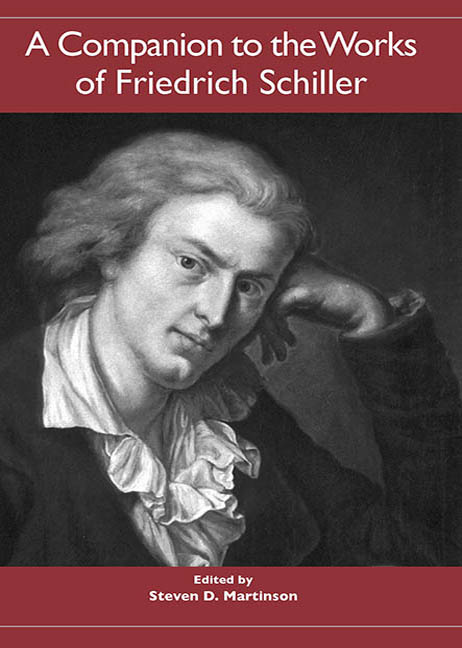Book contents
- Frontmatter
- Dedication
- Contents
- Acknowledgments
- The Works of Friedrich Schiller
- Editions and Abbreviations
- Introduction: Schiller and the New Century
- Intellectual-Historical Settings
- Major Writings
- Die Räuber: Structure, Models, and an Emblem
- Kabale und Liebe Reconsidered
- Great Emotions — Great Criminals?: Schiller's Don Carlos
- Concerning Aesthetic Education
- “On the Shores of Philosophy”: Schiller's Lyric Poetry, 1795
- Wallenstein
- Maria Stuart: Physiology and Politics
- Die Jungfrau von Orleans
- Wilhelm Tell
- Schiller's Legacy
- Works Cited
- Notes on the Contributors
- Index
Die Räuber: Structure, Models, and an Emblem
from Major Writings
Published online by Cambridge University Press: 28 April 2017
- Frontmatter
- Dedication
- Contents
- Acknowledgments
- The Works of Friedrich Schiller
- Editions and Abbreviations
- Introduction: Schiller and the New Century
- Intellectual-Historical Settings
- Major Writings
- Die Räuber: Structure, Models, and an Emblem
- Kabale und Liebe Reconsidered
- Great Emotions — Great Criminals?: Schiller's Don Carlos
- Concerning Aesthetic Education
- “On the Shores of Philosophy”: Schiller's Lyric Poetry, 1795
- Wallenstein
- Maria Stuart: Physiology and Politics
- Die Jungfrau von Orleans
- Wilhelm Tell
- Schiller's Legacy
- Works Cited
- Notes on the Contributors
- Index
Summary
Introduction
The playDie RÄuber (The Robbers, 1781) is a product of the times in which Schiller lived. As such, it can be understood only from within the panorama of contemporary history. At the same time, the drama also has a religious historical background, the structures of which are significantly more complex than previously acknowledged.
Of the four versions of Die Räuber, two stand out over and against each other, namely the first edition of the Schauspiel of 1781 and the Trauerspiel of 1782. The Trauerspiel has become the standard text for theater directors. Since the Mannheim premiere performance, in 1782, the version in the Soufflierbuch (stage text) has been staged. It forms the basis of the original performance and later variations. The Trauerspiel is most consistent with that text. In short, the Trauerspiel has been performed, while the Schauspiel has been read and interpreted. Although a series of interpretations have been published on the Zwote, verbesserte Ausgabe (Second Improved Edition, 1782) from a number of different perspectives, hardly any of these interpretations undertakes an in-depth analysis of the text. Scholarship has been even less concerned with the surface of the text. Such analysis reveals important differences not only between these two versions but, above all, among previous interpretations of the Schauspiel.Furthermore, Schiller's intentions for Die Räuber have been misunderstood, as they were even at the time of the premiere performance. While composing Die Räuber, the author addressed his manner of writing. In the suppressed preface to the drama, he writes: “Der Zuschauer vom gewaltigen Licht der Sinnlichkeit geblendet, übersieht oft sowohl die feinsten Schönheiten, als die untergeflossenen Flecken, die sich nur dem Auge des bedachtsamen Lesers entblößen.”
In the preface, Schiller makes the point that the work is to be comprehended not as a “theatralisches Drama” but, rather, as a “dramatischer Roman.” The poet has thus built finer elements (“die feinsten Schönheiten”) into the text that only the attentive reader can appreciate, elements that are lost in dramatic performance, or are overlooked by the spectator whose attention is diverted by the enigmatic qualities of the dramatic action. The formulation “feinste Schönheiten” refers to the ideal of everything that is beautiful in late eighteenth-century art. The finer component parts are combined according to the principles of symmetry and harmony. This observation must then call into question the classification of Die Räuber as a drama of the Sturm und Drang.
- Type
- Chapter
- Information
- A Companion to the Works of Friedrich Schiller , pp. 89 - 114Publisher: Boydell & BrewerPrint publication year: 2005

